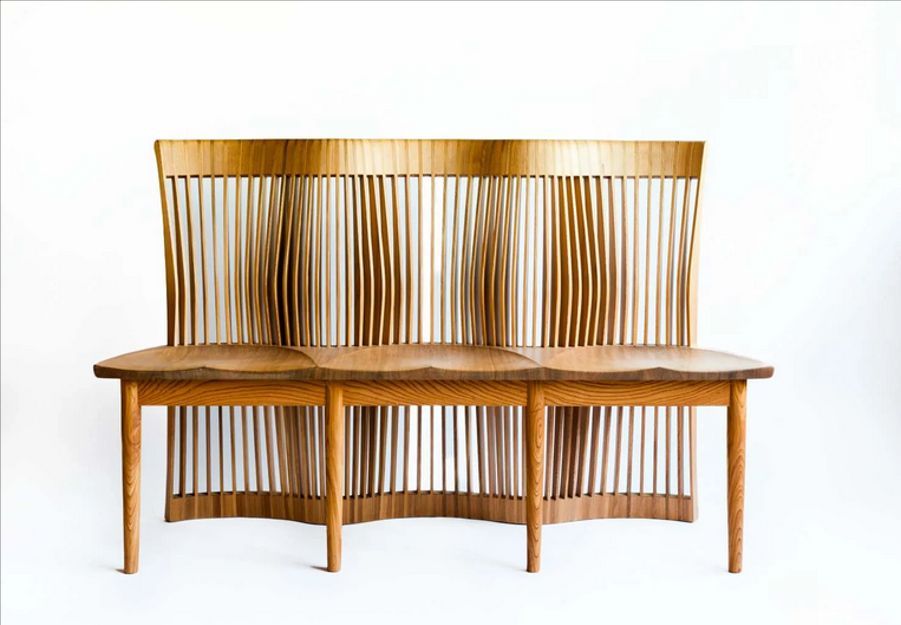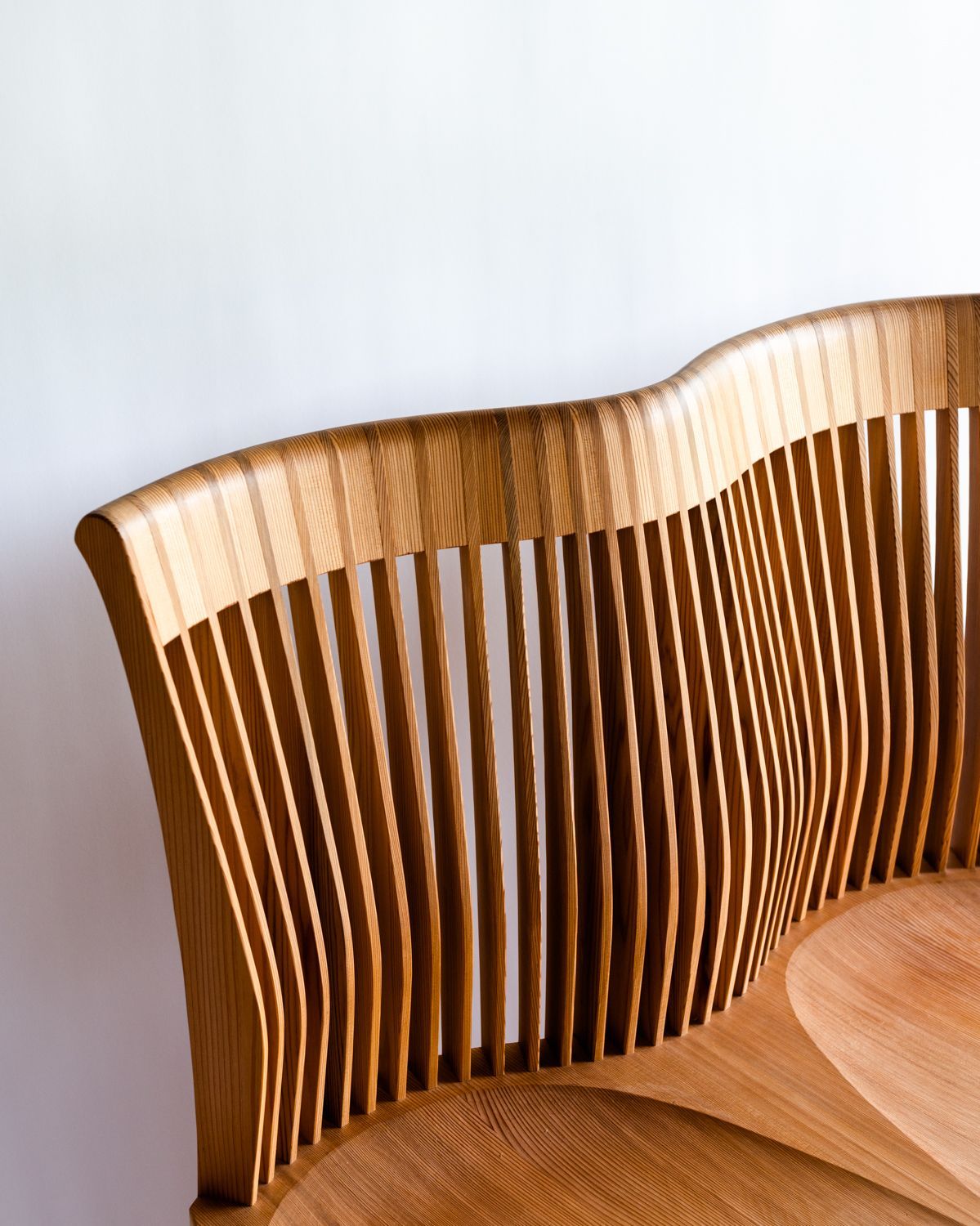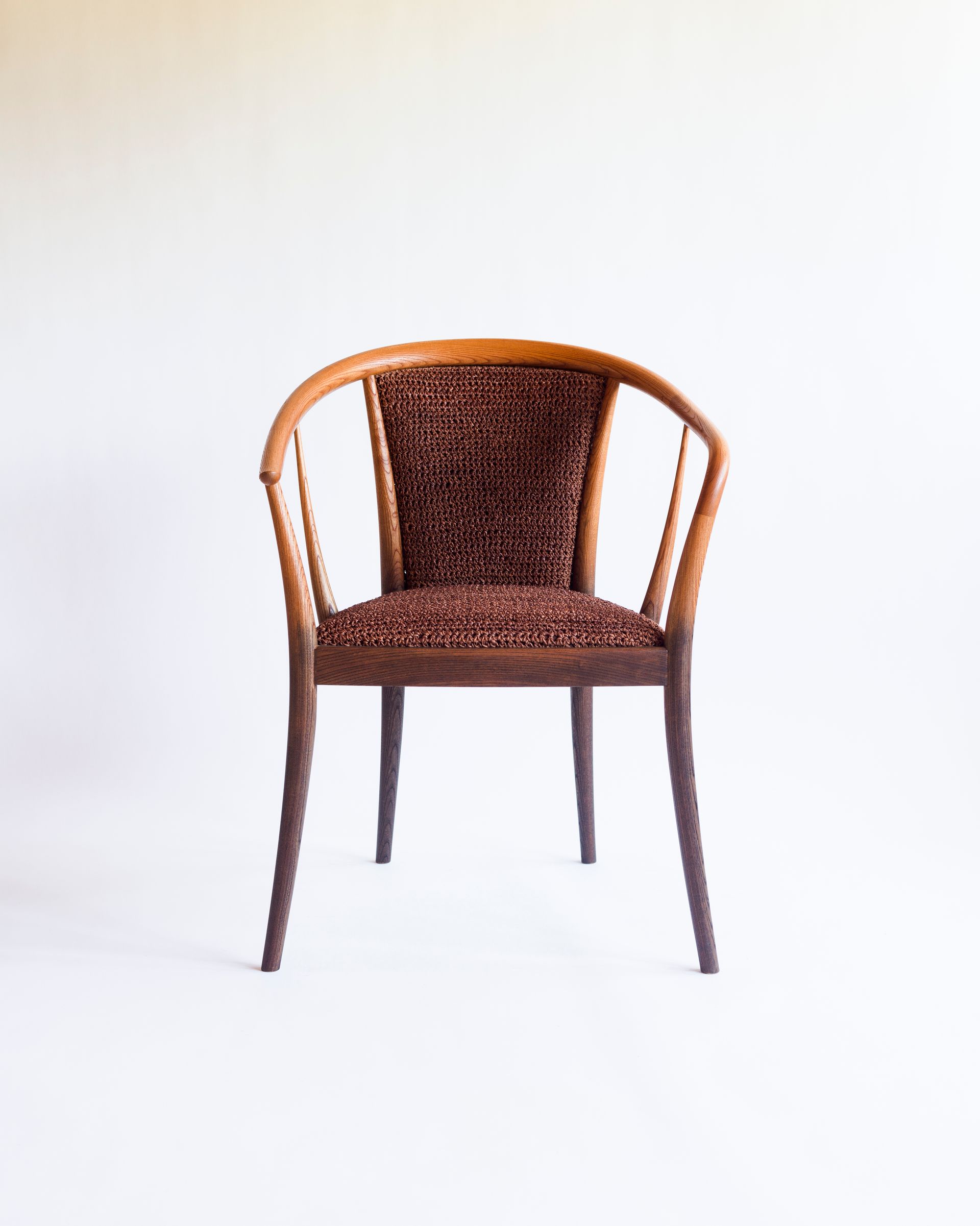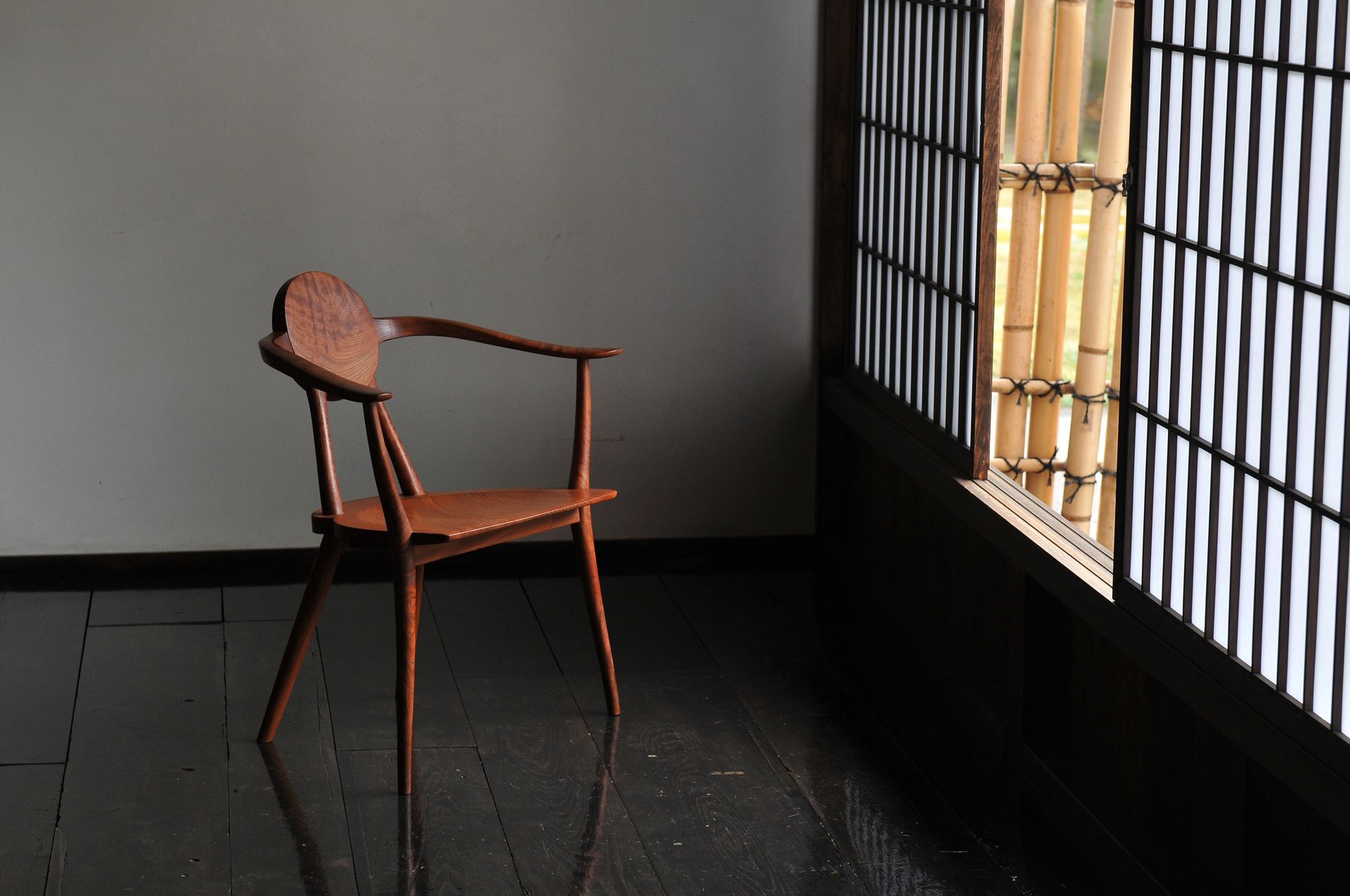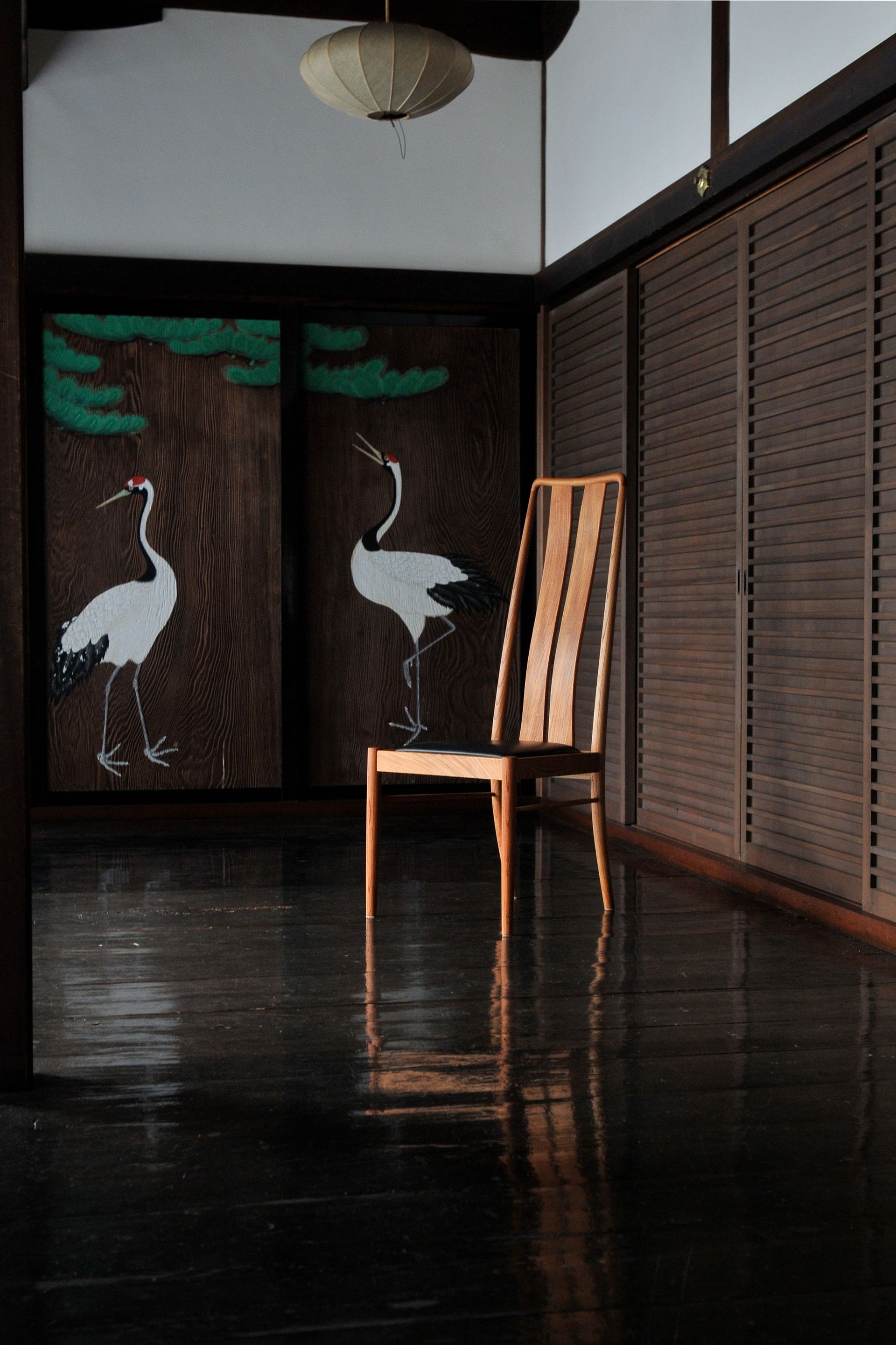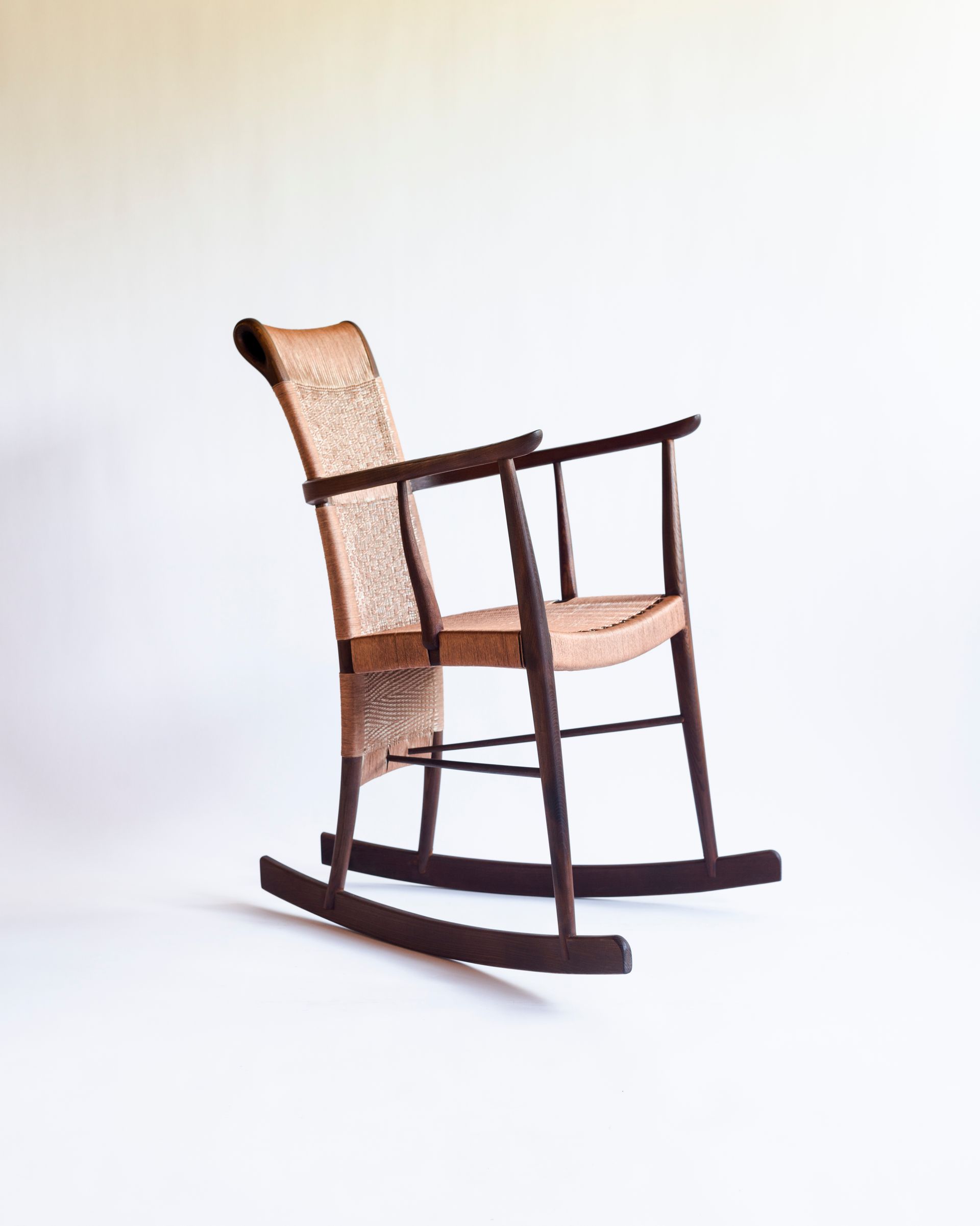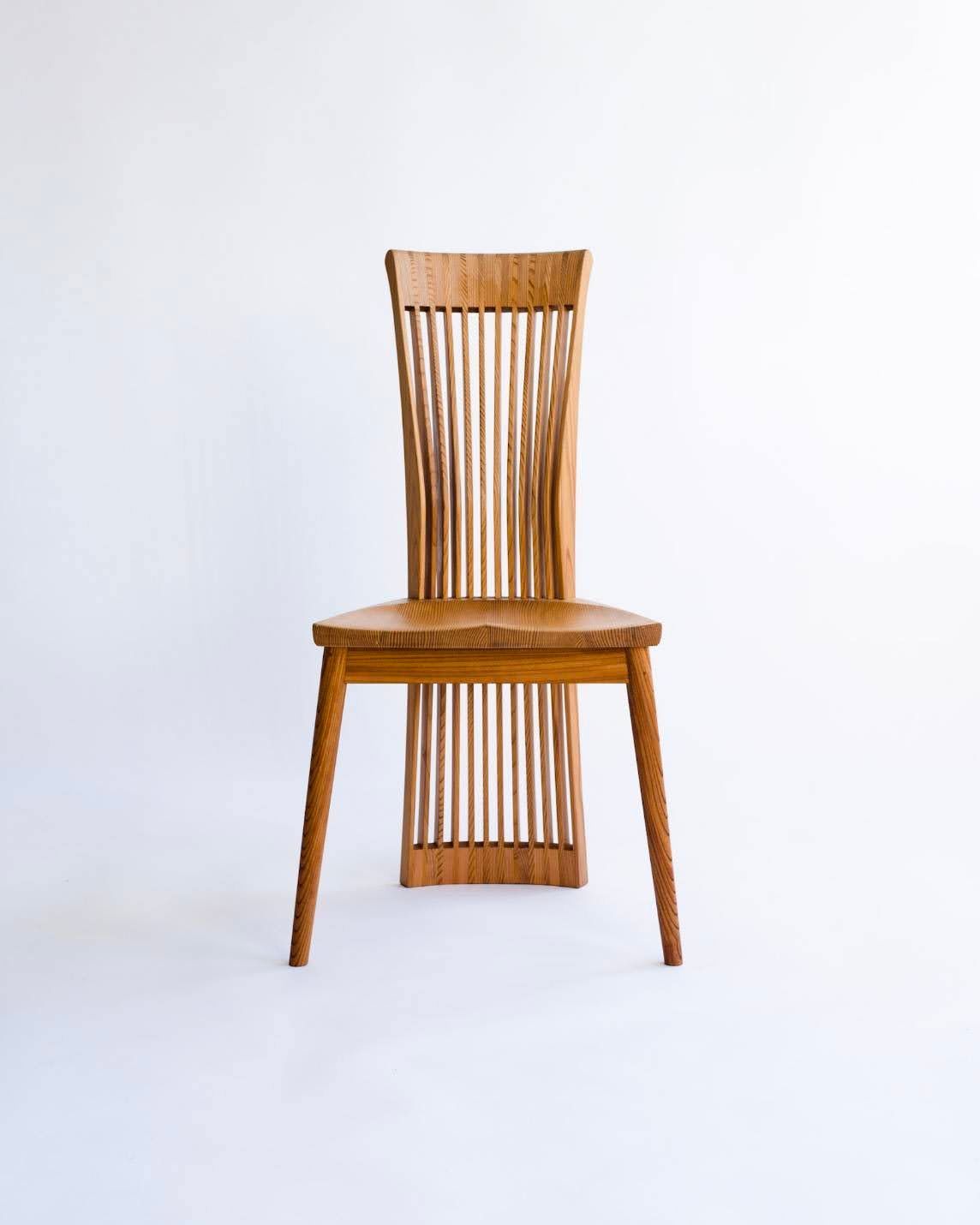The Kyoto Chair
ButtonThe exposed grain of this chair is an expression of Zelkova's exceptional warmth and beauty, enhanced by the four distinct seasons of the district in which it once grew.
w 695 × d 530 × h 795
Zelkova
Yuriko TOKUNAGA is a 2nd generation craftsperson specializing in meticulously hand-planed wooden furniture.
Yuriko TOKUNAGA
Furniture ・ Hyogo
-
Artist's Story
Yuriko TOKUNAGA is the daughter and disciple of Toshio Tokunaga, an acclaimed master of woodworking and planesmanship. Seven years ago, after completing her university education and living for a year in France, she returned to her family home to apprentice with her father. This decision came naturally to her, having been born and raised in the atmosphere of a woodworker’s studio.
Yuriko entered the JapanCraft21 Traditional Craft Revitalization Contest in 2022 and became the first-place winner of the Ronnie Prize. Her contest application focused on three points: promoting and developing plane use in furniture making, the expansion of the Tokunaga concept of hand-crocheted cushions using Japanese washi paper, and the revitalization of Satoyama.**
A few years ago, she purchased a ricefield adjacent to her family’s property that bamboo had overtaken for the past 60 years. Through her perseverance and by attracting like-minded volunteers, she has restored the rice patty to its original condition. **An iconic Japanese agricultural valley surrounded by forested mountains and bamboo groves, where traditional rural life utilizes local nature in ecologically sustainable agriculture and cottage industry.
-
About the Craft
The Tokunaga studio is located in an idyllic satoyama.** The mood of the workspace is very meditative in that the process is done almost completely without electric tools. Their three-person workshop iincludes founder Yoshio Tokunaga, his long-term first disciple, and his daughter and heir apparent, Yuriko. Together, they produce original wooden furniture using the senior Tokunaga’s unique, highly refined hand-wood plane process that produces a natural wood sheen and luster that increases over time. Tokunaga collaborated with a steel blade craftsman to create a series of tiny, two-way planes central to their furniture-making concept. Convention planes are moved in one direction - pulled in Japan, pushed in the west. Tokunaga’s planes work in both directions, allowing them to work rhythmically and continuously, moving planes back and forth without having to interupt the flow to change directions. A consistent line resulting from smooth back-and-forth movements is subtly seen on the surface of their finished work, regardless of the angle at which it is viewed. Completely rejecting any use of sandpaper because it severely scars the surface of the wood, their plane process opens the “pores of the wood.” A clear comparison between planed and sandpapered wooden surfaces can be seen via microscope. Surprisingly durable, hand-crocheted cushioning made from Japanese washi paper by the Tokunaga Studio adds softness and texture to their furniture. The studio’s vision is to re-invigorate and expand the culture of traditional, local hand-plane finishing while ensuring the sustainability of essential domestic raw materials through reforestation and supporting the resurgence of local satoyama culture for future generations.
**An iconic Japanese agricultural valley surrounded by forested mountains and bamboo groves, where traditional rural life utilizes local nature in ecologically sustainable agriculture and cottage industry.
-
About the Materials
Japanese Zelkova wood - Zelkova is a highly esteemed wood in Japan, prized for its beauty and versatility. The heartwood ranges from light to medium golden brown color and is distinct from the outer sapwood, which is lighter and yellowish-brown.
Zelkova boasts an elegant and dynamic grain pattern that runs irregularly in wavy formations, making it a popular choice for high-visibility furniture. The grain gives it resistance to cracking, denting, and marring. It generally maintains stability and resists warping despite changes in heat and humidity.
Zelkova is suitable for both hand and machine woodworking. It turns well, works well with glue, and has high versatility in furniture-design applications. Zelkova is ideal for high-end works where the natural beauty of the wood grain is showcased.
There is improved stability, color, and grain tightness with wood from older zelkova trees, and proper seasoning can further reduce warping or twisting.
Yoshino Cedar wood - Yoshino cedar (Cryptomeria japonica) has been cultivated in Nara Prefecture since the 1500s and is renowned for its uniform and dense grain. Stronger than commercially grown cedar from other parts of Japan, these meticulously cultivated trees produce wood ranging in color from white to shades of pink. Yoshino cedar is pleasantly aromatic, and its mostly knot-free appearance gives a clean and clear impression.
Initially, young Yoshino cedar saplings are planted very close together. As the trees grow, they are gradually thinned out for harvesting, thus allowing more room and sun to nurture the remaining trees. This consistent thinning-out harvesting process continues for over 100 to 200 years when the last, very large trees are finally cut.
Yoshino cedar is known for construction use, especially for high-end, high-visibility use. Traditionally, it has been used to make sake barrels because of its fragrance and resistance to rot and has commonly been used for different woodcrafts, including furniture making.
Mulberry wood - Mulberry wood is highly regarded in Japan for crafting furniture. The heartwood ranges from golden to golden brown, and a fine patina increases with age. Slowly, the color turns to chocolate brown over time, eventually penetrating the wood core itself. The color is especially appreciated in the Way of Tea (the tea ceremony world) for its subtle and refined elegant quality.
Mulberry wood is prized for two distinct surface patterns produced by different sawing methods. One is the medium-texture, straight grain achieved from plain sawing. The other is “ray flakes” or “ray flecks.” This beautiful natural pattern is achieved by sawing perpendicular to the growth rings, exposing the medullary rays.***
Mulberry is durable, maintains stability, and resists shrinking and warping, insects, and rotting. It has good longevity and resists weathering, so it is used for indoor and outdoor furniture. The wood has no characteristic odor,
Mulberry is suitable for both hand and machine woodworking. It turns well, works well with glue, and is highly versatile in furniture design applications.
***,Medullary rays are bands of cells that run from the center of the tree to the outside. They move nutrients between growth rings and store sugar in winter.
Washi paper from Kozo - The washi paper-making process was introduced into Japan from Korea in the early 600’s. Most washi is made from Kozo, the paper mulberry tree. Unlike wood pulp paper, which requires the felling of trees, washi production from kozo is very sustainable since the same trees can be harvested annually for about 40 years. The process begins with stripping the outer bark to access the white inner bark, then soaking it in water for several days to remove impurities. After boiling, the softened fibers are pounded and broken down into fibers, then placed in a vat of water. Adding a gelatinous fluid from a special plant root keeps the fibers in solution so they can more easily be scooped up on a bamboo screen and bound together. The screen size depends on the size of the paper being made. Rocking the screen causes the fibers to settle on the surface with a consistent thickness and facilitates the fiber bonding, resulting in strong and durable paper. Kozo washi is known for its long fibers. The longer the fibers, the greater the resulting paper’s strength, durability, and versatility.
.
Washi paper from Ganpi - The washi paper-making process was introduced into Japan from Korea in the early 600’s. Though most washi is made from Kozo, the paper mulberry tree, a smaller amount is made from the Japanese native ganpi tree, a member of the Zingcho flower family. The slow-growing and slow-generating gampi tree is harvested in the wild. Unlike wood pulp paper, which requires the felling of trees, washi production from ganpi is sustainable since the same trees can be repeatedly harvested over time. The process begins with stripping the outer bark to access the inner bark, then soaking it in water to remove impurities. After boiling, the softened fibers are pounded and broken down into fibers, then placed in a vat of water. Adding a gelatinous fluid from a special plant root keeps the fibers in solution so they can more easily be scooped up on a bamboo screen and bound together. The screen size depends on the size of the paper being made. Rocking the screen causes the fibers to settle on the surface with a consistent thickness and facilitates the fiber bonding, resulting in strong and durable paper. Ganpi washi has shorter fibers, making it smooth and shiny. It is durable and insect-resistant and often used in art for painting.
-
Tricot Chair
ButtonHand-planed wooden chair made from Mulbery wood will naturally turn to chocolate brown over time.
w 650 × d 555 × h 810
-
KOZA Chair
ButtonZelkova is a harwood typical in East Asia. Avenues and roads with Zelkova along the sides are familiar scenery in any part of Japan. The tree shape is an inverted triangle and may look lika a bloom or frame. Large and freely extended into the sky, the Japanese word for zelkova "keyaki" is said to come from the word "keyakeki" which means prominent, or outstanding. Zelkova is prominent as a lumber too, with its glorious pattern, strong presence and deepening color of brown. It sure is an outstanding ring porous wood of Japan.
w 650 × d 555 × h 810
Japanese zelkova
-
Vibrato Triple Chair
ButtonFeel the beauty and softness of conifer trees.
Vibrato chair aligned like a sound with dynamics, imagined as if the forests are moving with the wind.
w 695 × d 530 × h 795
-
Vibrato Triple Chair
ButtonFeel the beauty and softness of conifer trees.
Vibrato chair aligned like a sound with dynamics, imagined as if the forests are moving with the wind.
w 695 × d 530 × h 795
-
Crochet Chair
ButtonCushioning is made from washi paper that is cut into strips, twisted into paper cord, dipped into traditional persimmon tannin, and then twisted again. The cord is then crocheted into cushioning for this chair, resulting in comfortable, durable cushioning.
w 600 × d 480 × h 820
Zelkova
-
Crochet Chair
ButtonCushioning is made from washi paper that is cut into strips, twisted into paper cord, dipped into traditional persimmon tannin, and then twisted again. The cord is then crocheted into cushioning for this chair, resulting in comfortable, durable cushioning.
w 600 × d 630 × h 800
Zelkova
-
Mayu Chair
ButtonHandmade washi paper is cut into strips, twisted into paper cord, then crocheted into cushioning for this chair, resulting in comfortable, durable cushioning.
w 620 × d 670 × h 1160
Maple
-
F-type Chair
ButtonThe comfortable and durable cushion is made from domestically produced paper, cut into strips, twisted into paper cord, then woven onto a wooden frame using an original weaving method inspired by Japanese tatami mats.
Linen (persimmon dye), Leather and Japanese Cedar cushioning are also available.
w 585 x d 540 x h 715
Zelkova
-
SUN AND MOON CHAIR(SUN)
Buttonw 94 × d 81 × h 125
Japanese zelkova
-
US Ambassador's Residence Dining Chair
Button -
US Ambassador's Residence Dining Chair
Button -
US Ambassador's Residence Dining Chair
Button -
Kyoto Chair
ButtonThe Kyoto Chair was made from an 800-year-old zelkova tree that had stood at Daitoku-ji Zen monastery in Kyoto since it was founded in the early 1300s. The exceptionally beautiful grain of the wood clearly reflects the wood's and effectrs of four distinct seasons of Kyoto.
w 695 × d 530 × h 795
Zelkova
-
High Back Chair
ButtonThe High Back chair was hand-planed from Zelkova wood, with a comfortable cushion made from handmade washi paper that is cut into strips, twisted into paper cord, then crocheted into cushioning for this chair, resulting in comfortable, durable cushioning.
The other cushioning is available in linen (persimmon dye), leather, or Japanese Cedar.
w 460 x d580 x h1110
Zelkova
-
High Back Chair
ButtonThe High Back chair was hand-planed from Zelkova wood, with a comfortable, durable cushion made from domestically produced paper that is cut into strips, twisted into paper cord, then woven onto a wooden frame using an original weaving method inspired by Japanese tatami mats.
Linen (persimmon dye), Leather and Japanese Cedar cushioning are also available.
w 460 x d580 x h1110
Zelkova
-
M-Type Chair
ButtonThe comfortable and durable is made from domestically produced paper, cut into strips, twisted into paper cord, then woven onto a wooden frame using an original weaving method inspired by Japanese tatami mats.
Linen (persimmon dye), Leather and Japanese Cedar cushioning are also available.
w 600 x d 550 x h 725
Zelkova
-
Ganpi Rocking Chair
ButtonCushioning is made from handmade ganpi washi paper that is cut into strips, twisted into paper cord, dipped into traditional persimmon tannin, and then twisted again. The cord is then crocheted into cushioning for this chair, resulting in comfortable, durable cushioning.
w 610 × d 820 × h 950
Mulberry
-
Vibrato Single Chair
ButtonVibrato Chair is made from meticulously hand-planed Yoshino Cedar.
w 520 x d 550 x h 930
US Ambassador's Residence Library Sofa
ButtonUS Ambassador's Residence Library Sofa
ButtonUS Ambassador's Residence Library Sofa
ButtonEnd table
ButtonCustom wood planing tools
Tokunaga collaborated with a steel blade craftsman to create a series of tiny, two-way planes central to their furniture-making concept.





